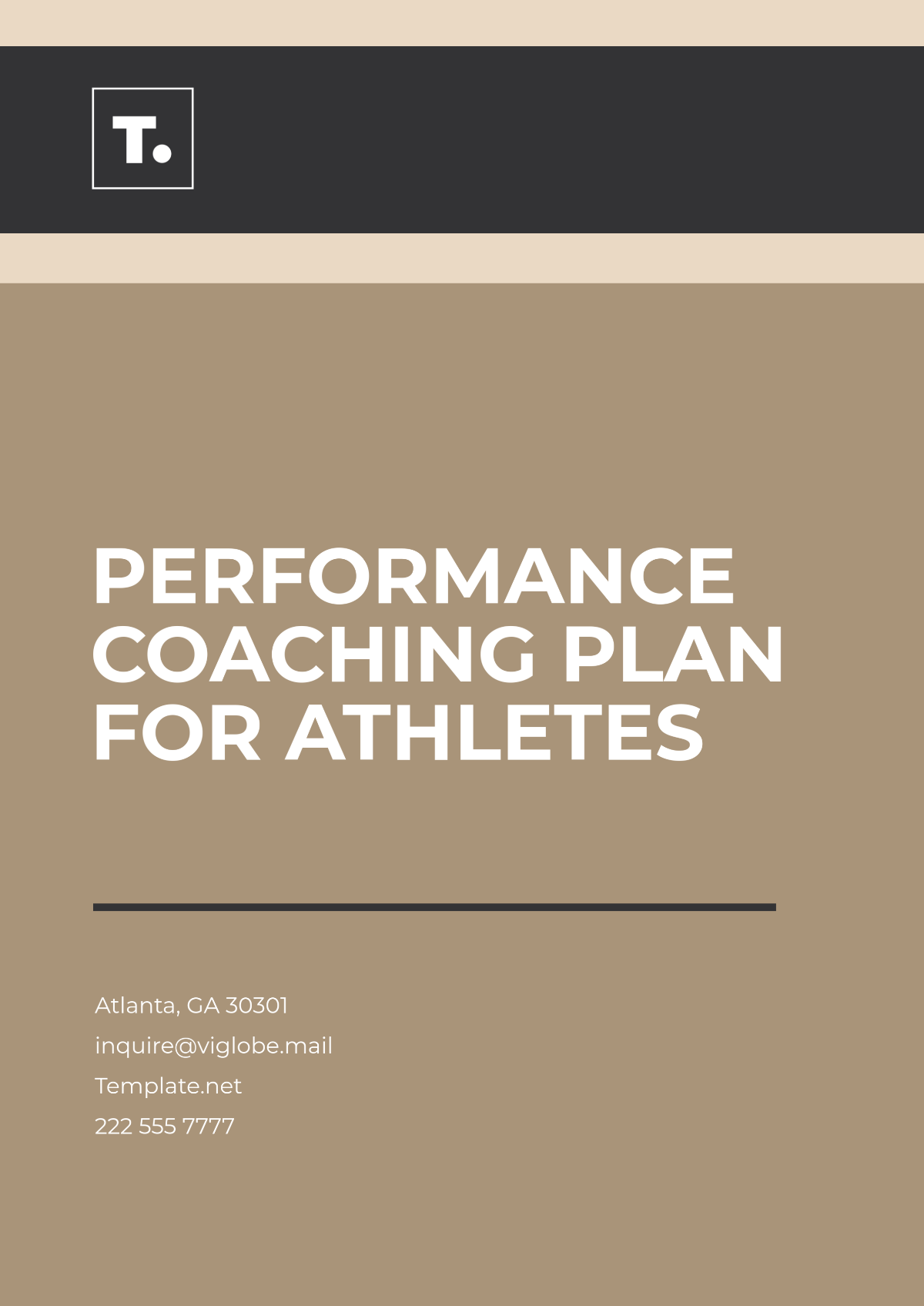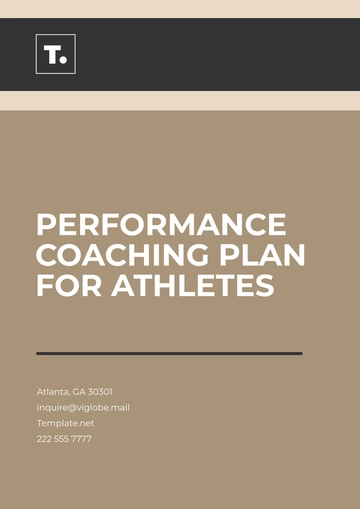Free Performance Coaching Plan for Athletes

Prepared by: [Your Name]
Date: [Date]
I. Goal Setting
A. Short-Term Goals:
Increase Sprint Time: Improve 100m sprint time by 0.2 seconds within the next 3 weeks. To achieve this, the athlete will focus on explosive starts and maintain a steady pace throughout the run.
Improve Endurance: Increase weekly running distance by 5 miles. The athlete will run 4 days a week, incorporating interval training on two days to build stamina.
Strength Development: Increase deadlift by 20 pounds in the next month by incorporating progressive overload during strength training sessions.
B. Long-Term Goals:
Competition Performance: Achieve a personal best in the upcoming regional championship, aiming for a top-5 finish. Focus on sharpening technique and mental readiness.
Sport-Specific Skill Enhancement: Improve agility and reaction time for soccer by practicing quick direction changes and sprinting in different directions, with a target of reducing reaction time by 10%.
Post-Season Development: Build strength, flexibility, and conditioning during the off-season, preparing for the next competitive cycle.
II. Physical Conditioning
A. Strength Training:
Workout Routine: Train 3 times a week with a focus on compound movements like squats, deadlifts, bench presses, and pull-ups. The athlete will perform 3 sets of 6-8 reps per exercise, with progressive weight increases each week.
Upper Body Strength: Incorporate push-ups, pull-ups, and shoulder presses to improve upper body strength and stability. Target 15 pull-ups in a single set by the end of the month.
B. Endurance Training:
Running: Increase long-distance running from 4 miles to 8 miles over the next 4 weeks. Initially, the athlete will aim for a steady 9-minute mile pace, working toward reducing this to 8 minutes per mile by the end of the month.
Interval Sprints: Perform sprint intervals (10 x 100m) with a 2-minute rest between sets. Focus on maintaining a consistent pace and reducing recovery time each week.
Cross-Training: Include cycling or swimming once a week to improve cardiovascular fitness without overloading running joints.
C. Flexibility:
Stretching Routine: Dedicate 15 minutes before and after training sessions to static and dynamic stretching. Focus on hamstrings, quads, hip flexors, and shoulders to improve range of motion.
Yoga: Incorporate a weekly yoga session to improve flexibility, joint mobility, and relaxation. Aim for at least one 60-minute class every week.
III. Technical Skills
A. Sport-Specific Techniques:
Sprint Technique: Focus on improving posture during sprints, keeping the body aligned for optimal speed. Implement drills that enhance the athlete's running form, such as high knees and butt kicks.
Ball Control (Soccer): Practice dribbling with both feet, improving control while maneuvering around obstacles at high speed. Dedicate 20 minutes daily to ball control exercises.
Form and Technique in Swimming: Work on refining stroke technique by focusing on the breathing pattern, arm movement, and kick coordination. Utilize video analysis to identify areas for improvement.
B. Tactical Training:
Game Awareness: Analyze past game footage and identify recurring mistakes or areas of opportunity. Discuss these observations with the coach to build a better understanding of in-game decision-making.
Situational Drills: Engage in drills that simulate game situations—such as defending in basketball or executing breakaways in soccer—designed to improve reaction time and decision-making under pressure.
Footwork Drills (Tennis): Implement daily footwork drills to improve speed and positioning on the court. Focus on short sprints, side steps, and transitions to react quickly to incoming shots.
IV. Mental Training
A. Focus and Concentration:
Visualization: Each week, dedicate 10 minutes before practice or competition to visualize the ideal performance, mentally rehearsing every aspect of the event. This helps build mental clarity and reduces anxiety.
Mindfulness: Practice deep breathing exercises for 5-10 minutes daily to improve concentration, calm nerves, and enhance focus during stressful moments in competition.
Cognitive Training: Use apps or tools that challenge cognitive processing speed and accuracy, helping sharpen the mind to stay alert in high-pressure situations.
B. Motivation:
Goal-Tracking System: Create a performance journal to record daily progress, challenges, and wins. Set mini-goals each week, such as increasing endurance by a certain distance or improving sprint times by a fraction.
Reward System: Use positive reinforcement. For instance, treat yourself to a small reward (e.g., a favorite meal, or a day off) after hitting key milestones in training or competitions.
Support System: Regularly communicate with teammates, coaches, and family members to stay encouraged and receive external motivation throughout the training process.
C. Resilience:
Mental Toughness Drills: Practice staying composed during failure by engaging in "failure drills"—forcing yourself to push through physical fatigue or mental stress.
Positive Self-Talk: Cultivate an internal dialogue that encourages persistence, using phrases like “I can do this” or “One step at a time” when facing difficult challenges.
Post-Setback Reflection: After a poor performance or injury setback, evaluate what went wrong and create a plan to improve rather than dwelling on the failure.
V. Nutrition and Recovery
A. Diet:
Pre-Workout Nutrition: Eat a balanced meal containing complex carbohydrates and lean protein 1-2 hours before training, such as a turkey sandwich with whole grain bread or a banana with peanut butter.
Post-Workout Recovery: Consume a high-protein snack or meal within 30 minutes of training to aid muscle repair, such as a protein shake or chicken and quinoa salad.
Hydration: Drink at least 3 liters of water daily, and incorporate electrolytes if training in hot or humid conditions. Avoid sugary drinks and focus on hydrating naturally.
Meal Plan: Work with a nutritionist to create a weekly meal plan that provides sufficient energy for training while supporting muscle recovery and overall health.
B. Rest and Recovery:
Sleep: Aim for 8 hours of quality sleep each night. Consider incorporating a power nap (20-30 minutes) after training sessions to restore energy levels.
Active Recovery: Use foam rolling, swimming, or light cycling as active recovery techniques after intense workout sessions to reduce muscle soreness.
Rest Days: Incorporate at least one rest day each week to allow muscles to recover and prevent overtraining. On these days, focus on light stretching or leisure activities like walking.
VI. Progress Tracking
A. Performance Metrics:
Strength Metrics: Track the amount of weight lifted each session to monitor improvements in strength. Set targets for each month to progressively increase weight or reps.
Endurance Metrics: Record time, distance, and pace for each run, aiming for steady improvement over several weeks.
Skill Metrics: Document improvements in technical skills by recording measurable outcomes, such as reduced reaction time or enhanced ball control.
B. Weekly Evaluations:
Check-In Sessions: Conduct weekly evaluations to assess the athlete's adherence to the plan, as well as any challenges encountered. Adjust the intensity of training or recovery methods as necessary.
Feedback Loop: Discuss progress and setbacks with the coach regularly, making adjustments to the plan based on real-time feedback.
VII. Review and Adjustments
A. Bi-Weekly Review:
Reassess the athlete’s goals, progress, and areas for improvement. Modify the plan if necessary to address changing needs or emerging weaknesses. Consider adding new focus areas, such as mental toughness or speed, depending on progress.
Seasonal Adjustments: During the off-season, reduce the intensity of competition-focused training while increasing emphasis on recovery, strength-building, and skills development.
B. Post-Competition Review:
After each competition, review performance in detail. Identify both strengths and areas needing improvement, such as race strategy, skill execution, or mental focus.
Update the coaching plan to address any areas for growth before the next major event, ensuring continuous development.
- 100% Customizable, free editor
- Access 1 Million+ Templates, photo’s & graphics
- Download or share as a template
- Click and replace photos, graphics, text, backgrounds
- Resize, crop, AI write & more
- Access advanced editor
Enhance athlete performance with the Performance Coaching Plan for Athletes Template from Template.net. This editable and customizable template is specifically designed to track progress, set performance goals, and structure training sessions. The Ai Editor Tool allows you to make real-time modifications to cater to individual athletic needs. Whether you're working with a beginner or elite athlete, this template helps you create a focused coaching plan that drives results and maximizes potential.
You may also like
- Finance Plan
- Construction Plan
- Sales Plan
- Development Plan
- Career Plan
- Budget Plan
- HR Plan
- Education Plan
- Transition Plan
- Work Plan
- Training Plan
- Communication Plan
- Operation Plan
- Health And Safety Plan
- Strategy Plan
- Professional Development Plan
- Advertising Plan
- Risk Management Plan
- Restaurant Plan
- School Plan
- Nursing Home Patient Care Plan
- Nursing Care Plan
- Plan Event
- Startup Plan
- Social Media Plan
- Staffing Plan
- Annual Plan
- Content Plan
- Payment Plan
- Implementation Plan
- Hotel Plan
- Workout Plan
- Accounting Plan
- Campaign Plan
- Essay Plan
- 30 60 90 Day Plan
- Research Plan
- Recruitment Plan
- 90 Day Plan
- Quarterly Plan
- Emergency Plan
- 5 Year Plan
- Gym Plan
- Personal Plan
- IT and Software Plan
- Treatment Plan
- Real Estate Plan
- Law Firm Plan
- Healthcare Plan
- Improvement Plan
- Media Plan
- 5 Year Business Plan
- Learning Plan
- Marketing Campaign Plan
- Travel Agency Plan
- Cleaning Services Plan
- Interior Design Plan
- Performance Plan
- PR Plan
- Birth Plan
- Life Plan
- SEO Plan
- Disaster Recovery Plan
- Continuity Plan
- Launch Plan
- Legal Plan
- Behavior Plan
- Performance Improvement Plan
- Salon Plan
- Security Plan
- Security Management Plan
- Employee Development Plan
- Quality Plan
- Service Improvement Plan
- Growth Plan
- Incident Response Plan
- Basketball Plan
- Emergency Action Plan
- Product Launch Plan
- Spa Plan
- Employee Training Plan
- Data Analysis Plan
- Employee Action Plan
- Territory Plan
- Audit Plan
- Classroom Plan
- Activity Plan
- Parenting Plan
- Care Plan
- Project Execution Plan
- Exercise Plan
- Internship Plan
- Software Development Plan
- Continuous Improvement Plan
- Leave Plan
- 90 Day Sales Plan
- Advertising Agency Plan
- Employee Transition Plan
- Smart Action Plan
- Workplace Safety Plan
- Behavior Change Plan
- Contingency Plan
- Continuity of Operations Plan
- Health Plan
- Quality Control Plan
- Self Plan
- Sports Development Plan
- Change Management Plan
- Ecommerce Plan
- Personal Financial Plan
- Process Improvement Plan
- 30-60-90 Day Sales Plan
- Crisis Management Plan
- Engagement Plan
- Execution Plan
- Pandemic Plan
- Quality Assurance Plan
- Service Continuity Plan
- Agile Project Plan
- Fundraising Plan
- Job Transition Plan
- Asset Maintenance Plan
- Maintenance Plan
- Software Test Plan
- Staff Training and Development Plan
- 3 Year Plan
- Brand Activation Plan
- Release Plan
- Resource Plan
- Risk Mitigation Plan
- Teacher Plan
- 30 60 90 Day Plan for New Manager
- Food Safety Plan
- Food Truck Plan
- Hiring Plan
- Quality Management Plan
- Wellness Plan
- Behavior Intervention Plan
- Bonus Plan
- Investment Plan
- Maternity Leave Plan
- Pandemic Response Plan
- Succession Planning
- Coaching Plan
- Configuration Management Plan
- Remote Work Plan
- Self Care Plan
- Teaching Plan
- 100-Day Plan
- HACCP Plan
- Student Plan
- Sustainability Plan
- 30 60 90 Day Plan for Interview
- Access Plan
- Site Specific Safety Plan

